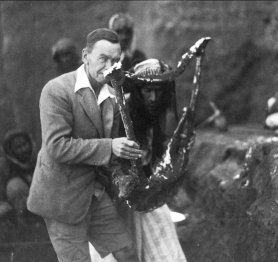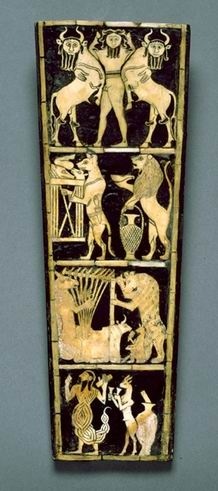The magical current we call Orphism undoubtedly entered the Greek speaking world from the East. The hymns contain the names of several Anatolian deities who were otherwise unknown in classical Greece, including some which were completely unknown save from the hymns until being rediscovered in inscriptions in Anatolian tombs. Personally, I believe the current to be extremely old, undoubtedly predating writing.

 When I imagine the archetypal Orphic lyre, I am always
When I imagine the archetypal Orphic lyre, I am always imagining the fabulous Lyres of Ur (modern Iraq). In the late 1920s, a team funded by the British Museum and the University of Pennsylvania excavated the royal tombs at Ur. Among the many treasures they discovered were three mid-sized lyres and one large harp, all of similar design. The reconstructed one pictured at the left is held in the British museum, along with another one of similar size coated in silver (called "the queen's lyre). A plaster mold taken by the archaeologists at the time of it's discovery is pictured above, to give you some idea of the scale of it. The finest of the three lyres, covered in gold, and was held by the National Museum of Iraq until it was stolen or destroyed in 2003. The final lyre, which is much larger, went to the Penn Museum in Philadelphia, where I first encountered it at the age about 12.
 The Great Lyre, called also The King's Lyre, pictured at left, is very similar to the one pictured above, although somewhat larger. You can see an entire gallery of images from all angles, including some showing restoration in progress, here. I was overawed when I saw the Great Lyre; his form burned into my mind. The great golden bull of heaven is often identified as Shamash, the sun god, Below the bull's head, a series of panel illustrations depict fantastical scenes. You can see them, with the head removed for greater clarity, on the right.
The Great Lyre, called also The King's Lyre, pictured at left, is very similar to the one pictured above, although somewhat larger. You can see an entire gallery of images from all angles, including some showing restoration in progress, here. I was overawed when I saw the Great Lyre; his form burned into my mind. The great golden bull of heaven is often identified as Shamash, the sun god, Below the bull's head, a series of panel illustrations depict fantastical scenes. You can see them, with the head removed for greater clarity, on the right. The first panel depicts the Lord of Beasts, wrestling with two animals. This is sometimes said to depict the control of nature exercised by the state. In the next scene, a hyena carries a tray of butchered meat, while a lion holds a large jar and a pitcher similar to some found in the tombs. (the dagger the hyena is wearing was also found) . In the next panel, a horse plays a lyre while a bear holds it steady. At the bear's feet, a small animal is playing a rattle. Finally, in the bottom panel, a deceased spirit meets the scorpion-man, guardian of the entrance of the underworld.
HERE you can listen to a replica of the lost golden lyre, accompanying a recitation of the Epic of Gilgamesh.

No comments:
Post a Comment